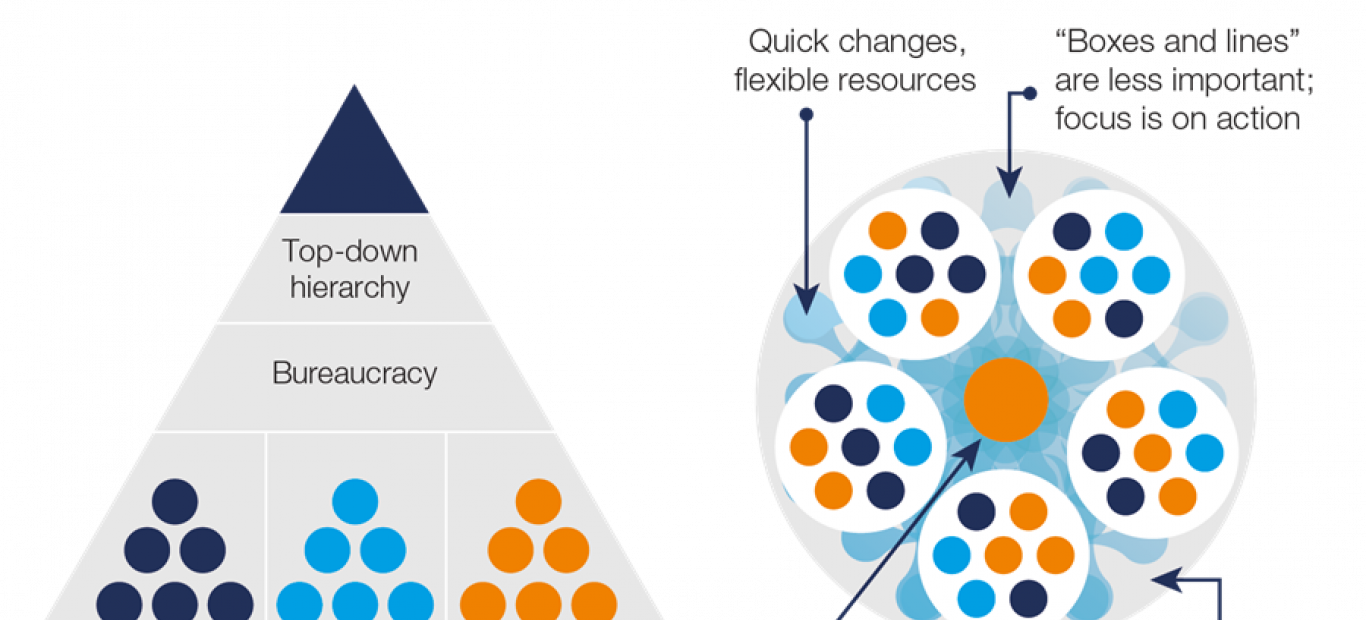Risiko Usaha
Agile Organization : The Answer of Current Business Environment
Background
In this industry 4.0 era, people demand to complete the things they need in very quick way. In addition, their demand itself can change rapidly. Many organizations (in every business sector) need to adapt in this situation in order to keep survive and gain much profit. This circumstances can be an opportunity for them to win the market competition or can be a disastrous condition since they failed to keep up with the changes. Therefore, to tackle these challenges organizations require an “agile transformation” [1]. This transformation converts traditional static organization to become an agile organization.
Traditional Organization
Traditional organization is an organization that emphasize in the scientific management. This organization focus on scientific approach to improve the efficiency (including labor productivity). The research-based technique organization products are project management, modern quality control, and total-quality management. This product lead to a hierarchy management, which the top position has the most control of the team. This approach is proven to be the best way to increase the company revenue in 1911 – 2011 [1].
As time goes by, the development in business competition is changing. Some of new challenges occur and the organization need to adapt. There are 4 main challenges. The first one is business environment evolving very fast. The business environment is changing rapidly. All of the stakeholders including customer, regulator, investor, and competitor has their own priority. For instance, customer and regulator want all of their need is quickly satisfied. In line with this, investor demand more profit and growth. As a result, there are so many merger and acquisition carried out. From the competitor point of view, they need to act very fast to fulfill market demand which changing very quickly [1][2].
The second one is the development of technology. In this industry 4.0 era, technology growing very fast. Many works could be done by using computer, IT system, robots, artificial intelligent, bioscience, and so on. The usage of technology would be very useful to meet customer demand because it will improve the work efficiency and increase the productivity [1][2].
Third is about easy access to gain information. Nowadays news and information are easily distributed. Not only because of the improvement in infrastructure but also the transparency. All of the stakeholders can get the information easily and it will affect their demand [1][2].
The last one is related to talent recruitment war. To survive in the evolution of business competition, company need people who are capable to adapt in industry 4.0 era. However, the supply of this kind of people is limited. Therefore, company need to compete to find the best talent available [1][2].
To tackle the modern challenges, traditional organization adapt by changing their management structure. Surprisingly, based on Mckinsey research, majority of traditional organization failed. Only 23 percent organization success to implement the restructuration [1][2].
Agile organization
Rapid changes in business environment, demand, technology, and regulation enforce the organization to adapt quickly [2]. To tackle these phenomena, organization need to evolve to keep up with all of the fast changes. Hence, agile organization is introduced. According to mckinsey [1], “Agile organization is a network of teams within a people centered culture that operates in rapid learning and fast decision cycles which are enabled by technology, and that is guided by a powerful common purpose to co-create value for all stakeholders”. It means that agile organization is a dynamic and not a structural basis organization which can make fast decision.
Based on Mckinsey study, the characteristic of agile organization are as follows: North star embodied across the organization, network of empowered teams, rapid decision and learning cycles, dynamic people model that ignites passion, and next-generation enabling technology [1]. These characteristics are referred to five essential elements: strategy, structure, process, people, and technology, respectively.
The north star embodied across the organization means that the organization has perfect fundamental philosophy. Company values, vision, and all of the strategic guidance should be clear and actionable. Consequently, all the people in the organization will understand at high level. Also, the objective of this understanding is so the employee will understand the job they are doing, both philosophically and technically. It will encourage the people spirit inside the organization and leads to increase the level of engagement to the company. The increasing of people’s senses of belonging will stimulate people to work in the same direction to satisfy company objective. Furthermore, employee in the organization is willing to be allocated in any group or division in the company because they believe that philosophically the job is same, the different is only the technical side.
From the structure point of view, agile organization prioritize in the network of empowered teams. The structure itself consider as a flat structure, however it must be clear. It means the flat structure is created based on company value [3]. With this type of structure, people feel easier to communicate and to collaborate because they feel no gap among them. Beside clear flat structure, the roles of the people should be clear as well. It makes the work more efficient because people already now what have to be done. Furthermore, people found what is need to be done and help others to get the job done. In this agile organization, people can share roles and one person can have many roles.
The third one is rapid decision and learning cycle. Agile organizations focus on several item in this point of view, there are [1]: rapid iteration and experimentation, standardize ways of working. The rapid iteration and experimentation mean that the people have a clear plan while finishing the work. They need to evaluate in the middle of the deadline to period and always check the progress daily. It can improve the effectiveness because they would not need to do the same job over and over again. Next, the standardize ways of working could appear because agile organization make people easy to communicate and collaborate so they can work together and the work quality would not be a much different among them [2]. The rest are performance orientation, information transparency, continuous learning, and action-oriented decision making.
Next, the dynamic people model that ignites passion. In the traditional organization, leader tend to be over controlled. They always give task and steer the employee’s work. In contrast, leader in agile organization encourage their team to take full responsibility regarding their job. They give a room to the employee to be creative in finishing their job and responsibility. As a result, employee will be motivated and automatically they will improve their own skill.
Finally, from the technology point of view, technology is become the most important thing in the business[1][2][3]. Not only the tools for the business support, but also the main engine to achieve the company goals, including satisfy customer demands. The rapid change of the business environment can be solved by utilize the technology effectively.
Conclusion
Rapid change in the business environment push industry to change the way to manage their organization. Restructuration is not an option since in the past only a few companies survived. Transformation is needed in the organization. The agile organization is the answer to keep up with the current situation of business environment by applying five characteristics: North star embodied across the organization, network of empowered teams, rapid decision and learning cycles, dynamic people model that ignites passion, and next-generation enabling technology.
Source:
1. The five trademarks of agile organizations: Mckinsey
2. How to create an agile organization: Mckinsey
3. How to mess up your agile transformation in seven easy (mis)steps: Mckinsey
Penulis





 11466
11466



 06 Aug 2021
06 Aug 2021 11837 kali
11837 kali









